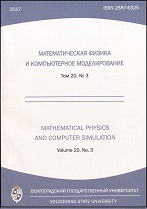|
Modeling, informatics and management
Methods of dissociative electron capture spectroscopy and density functional theory for modeling the biological activity of quinoxalin derivatives
M. M. Tayupov, R. G. Rakhmeev, A. V. Markova, A. M. Safronov
Institute of Molecule and Crystal Physics, Ufa Federal Research Centre, Russian Academy of Sciences
Abstract:
antimicrobial, antifungal, bactericidal and preservative properties, and are widely used in medicine and the food industry. The average lifetime of molecular negative ions (NI)relative to electron auto-cleavage is measured experimentally. The most probable structures of fragment ions [M-H]$^-$, formed during the decay of molecular NI, are revealed. Within the framework of the Arrhenius approximation, the value of the adiabatic electron affinity (EAa) was estimated. It is found that the theoretical values of $EAa$ calculated by the B3LYP/6-31+G(d) method with minimal addition of diffuse functions as the difference between the total energies of the neutral molecule and the radical anion correlate with the values of $EAa$ obtained from the experiment.
Keywords:
dissociative electron capture spectroscopy, quantum chemical calculations, resonant electron capture, toxic substances, cytochrome 450, medical preparations.
Received: 09.02.2021
Citation:
M. M. Tayupov, R. G. Rakhmeev, A. V. Markova, A. M. Safronov, “Methods of dissociative electron capture spectroscopy and density functional theory for modeling the biological activity of quinoxalin derivatives”, Mathematical Physics and Computer Simulation, 24:2 (2021), 54–67
Linking options:
https://www.mathnet.ru/eng/vvgum307 https://www.mathnet.ru/eng/vvgum/v24/i2/p54
|

| Statistics & downloads: |
| Abstract page: | 51 | | Full-text PDF : | 17 |
|




 Contact us:
Contact us: Terms of Use
Terms of Use
 Registration to the website
Registration to the website Logotypes
Logotypes








 Citation in format
Citation in format 